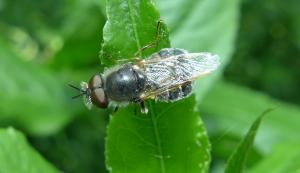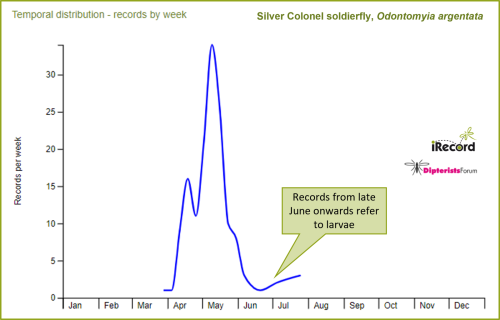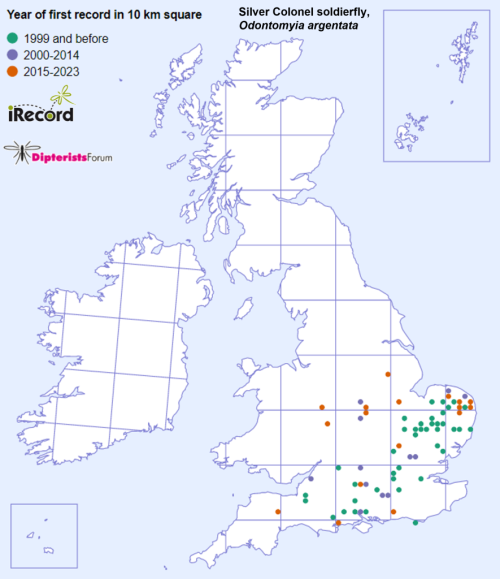Search for the Silver Colonel
Photo by Simon Knott
The Silver Colonel soldierfly (Odontomyia argentata) is a rare species with less than two hundred records on the recording scheme database. It has been recorded from 23 vice-counties altogether, all but two of which have records from this century. Encouragingly, there have been recent indications of a spread in range, with new county records from North Devon, Worcestershire and Shropshire within the last five years. Even so, the species is known from relatively few locations and is vulnerable to loss or declining condition of its wetland habitats, and we're keen to monitor how it is doing.
If you find this species please do add the records to iRecord, preferably with a photo if you can, or send them in to the scheme via one of the other routes. If you visit one of the known sites and don't find the fly please let us know that as well. Help with identification is always available via the soldierflies Facebook group, Twitter, or on iSpot.
When to look
Odontomyia argentata flies early in the year, starting in mid-April but with the majority of records in May, fading out in the first week of June.
How to recognise it
It is a species found in fens and marshes, where its larvae have been found in shallow pools and ditches. The adults are slow-moving flies, like most soldierflies, and can be found sitting on the vegetation or visiting flowers, including hawthorn and willow catkins. Odontomyia argentata is reasonably easy to recognise, especially in the male which has the distinctive silvery hairs on its abdomen that give the species its name. The hairs can appear dull from some angles, so try to get a view of it in good light, and if photographing take shots from several angles. Many thanks to Graham Calow for the images below (to which I've added annotations). More of Graham's photos can be seen at NatureSpot, and see also Steven Falk's Flick collection for this species.
Where to look
It is worth looking out for Odontomyia argentata in any fen, marsh or reedbed site in southern England, and also in wet woodlands if they have clearings and pools. Look around the edges of shallow pools and ditches, and on nearby flowers. Andrew Jukes reports finding one in a very small fen next to a car park in Bristol, so don't rule out tiny sites!
The map below shows all the 10km squares for which the recording scheme has records. There may be records missing from the scheme database, either because they haven't been sent it, or are in the backlog waiting to be dealt with - if you know of records that aren't shown on this map please get in touch. There are a few additional records (including one in south Wales) on the NBN Atlas.
Here are the records summarised by vice-county, with the most recently recorded counties first.
|



